Don't wanna be here? Send us removal request.
Text
Bring plants into flower
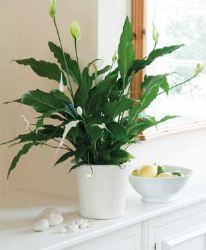
There are some house plants that will flower prolifically whatever you do with them. However, there are others that, having been chosen for their glorious flowers, only ever seem to sprout more leaves. Every house plant requires slightly different care to make it bloom again, plus a degree of patience.
Other difficult plants
House plants originate from all over the world, and naturally require different conditions in order to flower. The trick is to mimic these at home to coax reluctant types to bloom.
BROMELIAD The main part of a bromeliad dies after flowering, leaving new shoots to take its place. These can either be grown on as a group, or divided and grown on for a few years until mature. Once the bromeliad is as large as your original plant was when it flowered, place a clear plastic bag over it for a week, with a ripe apple inside. The apple releases ethylene, a gas that initiates flowering.
CLIVIA For this beautiful spring- and summer-flowering bulb to flower, it needs a period of cold dormancy. While it likes a warm spot for most of the year, from late autumn to late winter, keep it dry and at around 10°C (50°F). Water again from early spring, and give it a liquid feed every other week. As growth begins, move the plant to a warmer spot to flower, after which you should water it slightly less and begin the cycle again. Clivias like to be pot-bound, so repot infrequently.
CHRISTMAS CACTUS To flower well, Christmas cacti, Schlumbergera, need plenty of light during the summer. If grown indoors, keep them on a sunny windowsill. If placed outside, shade them a little to prevent them from scorching. To persuade them to flower, they then require short days and long nights. So, from autumn to Christmas, keep them in a room that is not lit at night, such as a spare room or a child’s bedroom.
MOTH ORCHID If the growing conditions are right, it is fairly easy to get beautiful moth orchids, Phalaenopsis, to re-flower. They don’t like too much light, so grow them on a west- or east-facing windowsill during winter, and in a shadier spot in summer. Water weekly in summer with rainwater, taking care to avoid the crown. Reduce watering in winter. If you have a plant in flower, just as the last bloom is fading, trim the spike slightly below where the first flower opened. A bud there will sprout a second flower spike, which itself can be trimmed to give a third. To encourage a moth orchid to flower again from scratch, keep it humid, give it a diluted feed once a month, and keep it at around 15°C (59°F) at night and 21–25°C (70–77°F) during the day. This fluctuation, combined with feeding and humidity, will initiate new flowers.
0 notes
Text
Add flower power to your home

Recreate a holiday atmosphere in your home with a selection of vibrant or scented tropical flowers that hint at beach-front promenades. Flowers provide colourful contrasts to cool, contemporary interiors, and many bloom for months without too much fuss — just keep them well fed and watered.
BRIGHT BRACTS Like colourful neon lights, vibrant bromeliad flowers and bracts make a bold statement that can’t be ignored. To show off these peacocks of the house plant world to full effect, present them against a clean, simple backdrop, such as a white windowsill. The bright bracts of most bromeliads last for many months, and the flowers peep out between or above them.
SURVIVAL STRATEGY Most bromeliads, including Guzmania, Tillandsia and Vriesea, are from the tropics and love the warmth of a heated home, but suffer if the humidity is low. Plant them in free-draining compost and water them regularly when in growth, reducing the frequency in winter. Take care not to overwater bromeliads, as soggy soil can kill them. To provide humidity, mist them once or twice a week with soft water or rainwater, applied at room temperature.
Floral scents
Why buy flower-scented air fresheners when you can have the real thing, and enjoy colourful blooms into the bargain? Take care when choosing a fragrant plant, as the intense perfume of some can be overpowering in asmall room.
PERFUMED PRIZES Choose between the compact gardenia, prized for its white, deliciously scented flowers and shiny dark foliage; an indoor jasmine, Stephanotis; and the wax plant, Hoya carnosa. The wax plant and jasmine are climbers and need space to grow, or train them around a wire hoop. All are highly fragrant and need bright light.
0 notes
Text
Plants for focal points

Tiny containers can look cute, but to create a statement, go for big, bold, sculptural plants in dramatic pots. Flowers also add punch but they are seasonal, so for year-round glamour focus on the leaves first when making your choices. Set more delicate plants in tall urns or on tables to raise their profile.
CHOOSING A STATEMENT PLANT Before buying a plant, think about where you would like to position it, and how much space you can afford. Plants with large dark leaves tend to prefer shade, while those with variegated foliage and palms enjoy more light. Cacti are happy in hot spots near south-facing windows, and the large types make striking features. Beware of their spines and hairs, though, as these will irritate your skin.
Also consider how quickly your plant will grow. Some, such as the bamboo palm, Dypsis lutescens, stay the same size for many years, while vigorous plants, like the sentry palm, Howea belmoreana, and Swiss cheese plant, Monstera deliciosa, can double their size in a couple of years, given the right conditions. PLACING YOUR PLANT Use your plant as a focal point to draw attention to an area of the room, or to provide a leafy contrast to the hard lines of cupboards and other furniture. Also, ensure the plant won’t be an obstacle, and choose a pot that matches your decor.
Architectural plant options
When choosing a house plant to make a bold statement in your home, either opt for one single dramatic specimen, or select a few smaller ones that combine well to create more impact. Unusual shapes and textures draw the eye, too, and can make up for size in smaller homes. If you love bright colours, select plants with blowsy blooms, such as amaryllis, or fiery bracts, like theVriesea species.
0 notes
Text
Orchid types

Before buying, check you can give your chosen orchid the temperature it needs. Remember that most require a 5°C (10°F) drop between day and night. WARM-GROWING Tender orchids, such as Dendrobium hybrids and Phalaenopsis, require warmth all year, with a minimum winter temperature of 16–18°C (61–64°F). They will tolerate occasional dips, and are fine in centrally-heated houses, if moved away from cold windowsills at night. INTERMEDIATE Cattleya, Epidendrum, and Paphiopedilum require more warmth than cool-growing orchids in winter, but will tolerate slightly higher temperatures in summer (see below). Most grow well indoors, but should be moved away from cold windowsills at night during winter.
COOL-GROWING This group includes Cymbidium and Oncidium, which prefer low temperatures all year. Stand them outside in summer in a sheltered spot, then bring them in to an unheated room, such as a cool conservatory or greenhouse, for winter,keeping them at around 8–10°C (46–50°F).
POSITIONING YOUR ORCHIDS As with watering, the light requirements of orchids differ depending on the type. Epidendrum grow on tropical tree branches in the wild and like bright indirect light. Cymbidium hybrids also prefer bright light, and should be set outside in a sheltered spot during the summer, then given a bright, cool position indoors out of direct sun, such as a conservatory or a frost-free porch, in autumn and winter. Cattleya and Oncidium prefer a bright position that offers some shade at midday, such as an east- or west-facing windowsill, but move them to a bright spot that receives sun all day in winter when light levels are significantly lower.If you do not have a light area in which to keep an orchid, choose a Phalaenopsis or Paphiopedilum hybrid. These dislike strong sunlight, preferring a shady site from late spring to autumn.
0 notes
Text
Grow exotic orchids
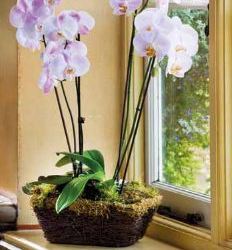
Sophisticated, stylish, and highly fashionable, it’s little wonder we all fall for elegant orchids. The problem is, many die off after flowering because they don’t receive the right care, or aren’t suited to life in a typical modern home. But choose your orchids carefully, and they can live long and happy lives.
CHOOSING PLANTS AND POTS When choosing an orchid, unless you are an expert, select one that enjoys conditions that you can provide at home, such as a moth orchid, Phalaenopsis, or a Cymbidium. If you can keep your plants in a heated greenhouse, your choice is wider. Hybrids of the following orchids are generally reliable, given the right conditions (see opposite): Cattleya, Dendrobium, Epidendrum, Oncidium, and the slipper orchid, Paphiopedilum. Before buying an orchid, look over the plant for any signs of pests and diseases, and make sure it has plenty of flowers and firm buds. Check that the aerial roots are firm and pale with green tips, and that any roots visible through a clear plastic pot (which orchids are often grown in) are equally healthy, and not black.
Most tropical orchids have aerial roots that absorb water and photosynthesize like leaves, taking energy from the sun and converting it into food. This means they can survive in very little compost, and require only small containers. Some should be grown in transparent pots to enable the roots to absorb sunlight.
WATERING AND FEEDING The most common cause of an orchid’s early demise is over-watering. Although different orchids have different needs, most require watering once or twice a week in spring and summer, and once a fortnight in winter. In the case of Cattleya, water just enough to prevent the pseudobulb (the swelling at the base of the stems) from shrivelling. Keep Dendrobium almost dry in winter Use a can filled with tepid rain- or filtered water, and pour it into the pot until it runs from the base. For plants with congested roots, submerge the pot to just below the rim in a bowl of water, and leave until the compost surface is damp, then remove and leave to drain. Also provide some humidity by misting the leaves with rain- or filtered water, avoiding the flowers; or sit the pots on a tray of damp pebbles or gravel . Orchid compost contains no nutrients, so start feeding your plants with a proprietary orchid fertilizer as soon as you get them home, following the instructions on the packet. Some orchids, such as Phalaenopsis, should be fed weekly, while others need less frequent applications.
0 notes
Text
Mix and match a display

Solitary small and medium-sized house plants can look lost on a shelf or windowsill, but when grouped together on a tray, they form a lively display of contrasting colours, shapes, and textures. A layer of pretty pebbles sets off the flowers and foliage, and when the tray is filled with water, they help to provide the humid atmosphere that these plants enjoy.
Alternative effects
As well as grouping containers, create displays by using different plants in one large pot, or repeating a single house plant species throughout your home.
MATCHING HOUSEPLANTS When using one large pot for a variety of plants, make sure that you marry up those that enjoy the same conditions. Groups of ferns were very fashionable in Victorian times and are now de rigueur once more; these leafy shade-lovers look great in a large glass bowl or contrasting smooth white pots. You could also try large foliage plants, such as angel wings, Caladium, edged with delicate maidenhair ferns like Adiantum. For a hot, sunny windowsill or table, create succulent and cactus displays where natural desert conditions are easy to emulate.
0 notes
Text
Homes for birds and bees

Birds and beneficial insects not only make a garden a more interesting place, they also help to control pests and improve flower pollination. Gardening organically helps make them feel welcome, but providing a specially made home really rolls out the red carpet and encourages them to stay.
Choosing and siting a nest
Encourage birds to visit your garden and you will have a ready army of pest-eaters on your side. If you can persuade them to make their nests and rear their young there too, they will make a fascinating animated addition to the flowers and foliage. Put up one or two nest boxes, and see who moves in.
CHOOSING THE RIGHT BOX Birds are picky about where they live, so it is important to choose the right type of box. Select one that is made from an insulating material, such as wood or woodcrete to prevent them from becoming too hot or cold, and avoid any made from ceramic or those with metal roofs. Correct hole size is also important: too small, and the birds you want to attract may not fit; too large, and wind, rain, and even predators may get in. The box should be robust, waterproof, safe, and comfortable. Different bird species have different needs, so if you want to make a home for a particular type of bird, do some research first and find out what suits it.
SITING YOUR BOX Nest boxes should be sited in a sheltered place, away from strong sunlight, wind and rain. Position them in the quietest area of the garden, away from feeding areas, and at least 1.5m (5ft) above the ground. This mimics the nesting places birds naturally prefer, and keeps them safe from predators. Choose a position away from large branches where cats can lurk, but where there are flimsy twigs nearby to give fledglings somewhere to perch when they first leave the nest. The best time to put up nestboxes is outside the breeding season, between midsummer and late winter.
0 notes
Text
Composting essentials

Composting conveniently disposes of your garden cuttings and trimmings, while at the same time creating a free, and wonderful, soil improver. It can be as simple as throwing all your waste into a pile and forgetting about it, but you will get better results if you follow a few simple guidelines.
CHOOSING A BIN Bog standard plastic compost bins are functional, rather than attractive, but do hold lots of garden and kitchen waste. They are also the most inexpensive, and can often be bought at a discounted price through your local council. If you are concerned about how your compost bin fits in with the rest of the garden, there are more attractive options, including wooden bins designed to look like bee hives that can be stained to suit your garden design. These are a good choice for smaller gardens where the bin would be on view. Impatient gardeners may prefer “tumbler” bins. These allow you to make small batches of compost in weeks, not months, by turning the bin to increase airflow, which naturally speeds up the composting process.
FILLING YOUR BIN To produce good compost it is important to have the right mix of ingredients. If you add too much soft, green material, such as grass clippings, the heap may turn into a slimy, smelly sludge. Put in too much dry, woody material,and it will rot down slowly, if at all. Ideally aim for a ratio of about 50:50. During most of the year, it is likely that you will be producing more green than dry material, so you will need to search around for dry waste to add. Woody prunings are best, but brown cardboard,crumplednewspaper, and even the insides of used toilet rolls all make suitable alternatives.
QUICKENING THE PACE Air is essential to the composting process, so the contents must be turned regularly to ensure good airflow throughout your bin or heap. Turning also allows you to check how things are going, to wet the mix if it is too dry, or to add dry material if it is too wet. This task is easier if you have two bins, but if you only have one, simply empty it out onto a tarpaulin, mix the contents well, then refill the bin.
0 notes
Text
Plant trees for wildlife
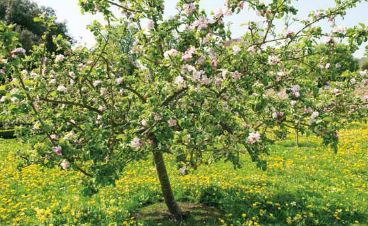
Trees are among the best features for wildlife.In urban areas, in partilura , the act as beacons ina sea of streets and housing, signalling to birds that rest and shelter are on offer. They provide nesting and roosting sites, a home for insects and other wildlife, and many are a great source of food. Every garden should have one; no matter how small the site, there are trees to suit.
INSECT FEASTS Fruit trees, such as apples and pears, provide a sweet feast late in the year, but they are also rich sources of nectar when they blossom in spring. As soon as their first flowers open, these trees are alive with hungry bees, pollinating the flowers as they feed and ensuring a bountiful harvest later in the year. Native trees, such as hawthorn (Crataegus) and elder (Sambucus), are particularly good for wildlife, producing an abundance of nectar.
FOOD SOURCES FOR BIRDS Berries are an attractive feature in a garden, glowing in the low autumn sun, and they also provide a sustained food source for birds and animals that can last well into the winter months. If you have space, plant several fruiting trees that ripen at different times to ensure an enduring supply. Good choices for an abundance of berries are whitebeam (Sorbus aria), rowans (Sorbus), mulberries (Morus nigra), elderberry (Sambucus) and cherries (Prunus). No berries will go to waste, with any windfalls readily eaten by birds, small mammals, and even butterflies. If you have a bumper crop of fruit and berries, consider freezing some to put out in late winter when food is scarce.
NESTING SITES Trees become more valuable to wildlife as they get older; a mature tree will become home to birds that regularly return, year after year. Trees with dense crowns and bare trunks are particularly prized by birds, as they provide sheltered nesting sites, and keep predators at bay. Once mature, a holly tree (Ilex) has everything: berries, dense growth, and thorns that keep out all but the most determined intruders. Other excellent prickly trees are hawthorn (Crataegus) and blackthorn (Prunus spinosa). If you don’t have space for mature trees, all three make great wildlife hedges that offer similar protection for nesting birds (see pp.192–193). Older trees require maintenance, and it is essential that you carry out any pruning and routine care outside of nesting time, otherwise you risk upsetting nesting birds or fledglings, which is against the law.
0 notes
Text
Cherries and plums
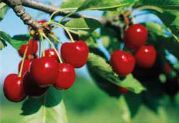
PLANTING AND CARE Plums and cherries should be planted in autumn or winter, much like apples and pears. Once they are established and fruiting, it is important to protect cherries from birds, or they will quickly finish off the crop. A net thrown over the tree will provide some protection, but for best results, grow them in a specially constructed fruit cage. Plums and cherries should always be pruned in summer, and never in winter, as they are susceptible to silver leaf disease , which is more prevalent in winterLuscious and juicy, cherries and plums taste of summer. Both are grown as standard trees, but cherries can also be trained along a warm, sheltered wall.
CHOOSING VARIETIES You can grow sweet or sour cherries. Sweet are the best for eating from the tree and sour are ideal for cooking and jam-making. Cherries can grow into large trees, so select one grown on dwarfing rootstocks – Colt or Giselle 5 – and a self-fertile cultivar if you only want one tree. Some varieties of plum are particularly good for eating, some are better for cooking, and others are dual purpose.
0 notes
Text
Plant a tiny orchard
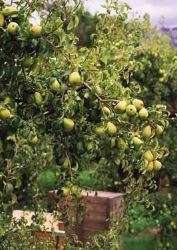
Fruit trees work hard for their keep, providing a strong winter outline, a spring show of beautiful blossom, and a bountiful harvest in summer and autumn. They need little care once established and are well suited to small- and medium-sized gardens, particularly when they are grown on dwarfing rootstocks.
Apples and pears
These fruit-bowl regulars make characterful garden trees and their crop is unlikely to go to waste in most households. As they age, the trees take on a wonderfully gnarled appearance which sets off their spring blossom perfectly.
CHOOSING VARIETIES Depending on the variety you choose, apples and pears ripen from late July to late autumn. You can choose pears with a soft, buttery flesh or a more solid texture. The taste of apples varies enormously between varieties so read descriptions before buying. If you want a tiny apple tree go for one on M27 rootstock. For a tree about 3m (10ft) high, choose MM106. Pears grown on Quince A rootstock will reach 3–6m (10–20ft) in height.
PLANTING AND CARE Autumn and winter are the best times to plant apples and pears. Bare-root trees become available at this time of the year, and they are less expensive and establish just as quickly as pot-grown trees. Plant bare-root types as soon as you can after receiving them. Dig over the area around the planting hole and add some organic matter. Plant at the same level as the trees were in the field (look for the dark stain on the stem). Firm in well. Water in, then insert a stake (see p.179) and tie the tree to it. Mulch with bark chippings or compost, and keep well watered for the first two years.
0 notes
Text
Fruit for large containers
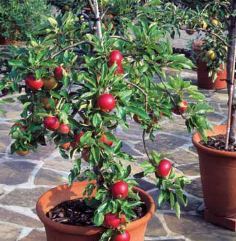
You can grow a mini-orchard of fruit in patio containers if you’re happy to water and feed regularly. Choose from soft fruits, such as currants and gooseberries, or tree fruits like apples, pears, and cherries, grown on dwarfing rootstocks. Renew the top layer of compost every year for the best crop.
RED, WHITE, AND BLACKCURRANTS These delicious fruits need moisture-retentive soil, and those in pots must be watered regularly during the growing season. Plant them in large containers filled with soil-based compost, such as John Innes No.3, mixed with well-rotted organic matter — garden compost or manure is ideal. You can either grow them as bushes or train them on a trellis like a climber . Apply a general fertilizer for fruit crops in spring, and top up with tomato fertilizer every week from late spring until the fruits ripen. Cover the blooms with fleece if frosts are forecast. Site in a cool, partly shaded spot. For pruning, see gooseberries .
GOOSEBERRIES The sharp sweetness of gooseberries is perfect for summer puddings and pies. Planting and feeding requirements are the same as for currants (see above), and if the crop is heavy, thin the fruits in late spring. Every winter, cut back the main stems by one half to an outward-facing bud, and prune the sideshoots to one bud from the main stems (beware of the spines). Keep the plants well watered and harvest ripe fruit in summer.
PEACHES AND CHERRIES The best fruit trees for pots are those grown on dwarfing rootstocks that produce full-sized fruit. Cherries are grafted on to Colt or Gisela 5 rootstocks, and peaches on Pixy or St Julien A. Good cherries include ‘Compact Stella’ and ‘Maynard Mini Stem’; for peaches try, ‘Bonanza’ and ‘Garden Lady’. Plant in large pots of soil-based compost, such as John Innes No.3, keep in a sheltered, sunny spot, and protect the blossom with fleece. Feed in spring with all-purpose fertilizer, and apply tomato food every fortnight after flowering. No pruning is needed.
APPLES AND PEARS Popular for pots, apples grown on the dwarf rootstocks M27, M9, or M26, which should be stated on the label, are widely available. The choice of pears is smaller, but look for those grown on Quince C or Quince A. All these compact trees produce full-sized fruit. If you have space, grow several and enjoy a variety of different flavours from late summer and throughout the autumn. Popular apple varieties include ‘Egremont Russet’, ‘Cox’s Orange Pippin’, ‘Discovery’, golden yellow ‘Elstar’, and ‘Blenheim Orange’, with its crisp, nutty flavour. The pear varieties ‘Williams’ Bon Chrétien’, ‘Doyenné du Comice’ and ‘Dwarf Lilliput’ are ideal for containers. If space is really limited, you can buy two different fruits grafted on to one rootstock, offering two flavours for the price of one. Planting and care is the same for apples and pears . Keep pots well watered throughout the spring and summer.
0 notes
Text
Grow super fruit
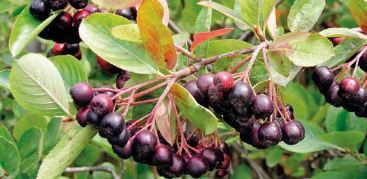
Every few years another food is labelled a “super food” because of its high levels of antioxidants, vitamins, and nutrients. Many of these berries are easy to grow in your own garden, and on a patio in a large container, giving you instant access to some of the healthiest foods available.
Aronia berries
Commonly known as chokeberry, Aronia has the highest level of cancer- and age- fighting antioxidant, anthocyanin, of any fruit. The berries are tart when eaten raw, and are best combined with other ingredients or sweetened.
GROWING TIPS Aronia grows well in a range of conditions, but is best in a moist, acidic soil, in partial shade or full sun. Incorporate plenty of organic matter before planting. It is a large, shubby plant, reaching 2m (6ft) tall, with a 3m (10ft) spread. As attractive as it is productive, Aronia flowers in late spring, and has superb autumn colour that complements the dark berries, so plant where it will be seen.
AFTERCARE This plant should be kept moist at all times, especially during the first year. Apply a thick mulch of chipped bark after planting to help retain moisture and suppress weeds. Aronia takes a few years to establish and reach full productivity, so be patient. You may need to protect plants from birds when the berries are ripe; they develop their best flavour after hard frosts.
Goji berries
These berries contain large amounts of vitamin C and iron. In China they are most often used in savoury dishes, such as soups – a handful is thrown in towards the end of cooking – or they are stewed to make tea.
GROWING TIPS Goji plants are fully hardy shrubs, and prefer fertile, well-drained soil in a sunny spot. When planting, incorporate lots of well-rotted organic matter, such as farmyard manure, and keep them wellwatered for the first year. They flower in late spring and summer, but are unlikely to produce a worthwhile crop until the third year after planting.
DRYING BERRIES Use the berries when fresh, or dry them for storing. Place them in the oven on its lowest temperature, with the door open, for a few hours, then store the berries in clean, dry, airtight jars.
0 notes
Text
Choosing conifers
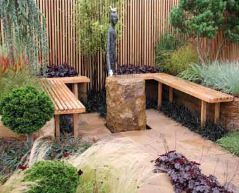
Conifers comprise a wide group of mostly evergreen trees and shrubs that provide welcome colour and structure all year round. Although some have a bad name, growing into ungainly monsters, many make elegant additions to small gardens, especially when combined with other woody plants and perennials.
SIZE MATTERS The following plants are examples of the different types of conifer you may see in garden centres and catalogues. Check their labels carefully to ensure you buy a conifer that will suit your plot. “Slow-growing” conifers are not necessarily small, they simply grow slowly, putting on 15–30cm (6–12in) of growth per year. “Dwarf” types remain compact, and grow between 2–15cm (1–6in) per year, while “Miniatures” are tiny and will only grow to about 25cm (10in) after ten years and ultimately reach no more than 90cm (3ft).
Creative effects
Conifers are excellent design tools, offering a wealth of colours and shapes. You can use them en masse for a mosaic effect, choose just one striking example for a focal point in a border or lawn, or plant tiny types in pots and containers.
DESIGN OPTIONS For year-round colour, you can’t do much better than the blue spruce, Picea pungens, which comes in all shapes and sizes and makes a great companion for purple-leaved shrubs, such as the smoke bush, Cotinus ‘Grace’. Alternatively, match them up with contrasting golden conifers, such as the spreading Juniperus x pfitzeriana Gold Sovereign or the rounded Chamaecyparis lawsoniana ‘Golden Pot’. To strike a pose, look for pencil-thin plants that provide accents and can be used as focal points, or to line a path. The Italian cypress, Cupressus sempervirens, is a classic example, but junipers are easier plants for cooler climates. Try J. communis ‘Compressa’ or ‘Sentinel’, which have a similar rocket-like form.
Options for small gardens
Conifers are quite easy-going and adapt to a range of conditions, but most thrive in a sunny site in moist soil that drains freely, although junipers will cope with drier conditions. Check labels for width as well as height, as some needspace to spread .
0 notes
Text
Cover up for winter
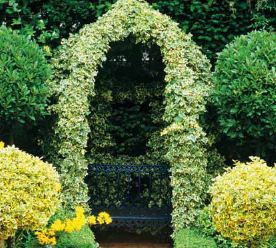
Cold, dark winter days can be depressing, but with a few well-chosen climbers to dress up your screens, boundaries, and bare-stemmed trees, this can be an exciting and beautiful season. Bright, variegated foliage, sunny yellow flowers, and sweetly scented blooms are among the delights in store.
Ivy arch
Often overlooked or dismissed as too common, ivy comes into its own in winter, with beautiful leaf shapes and bright colours. Grow it over an arch for a spectacular foliage effect.
Seasonal gold
The winter jasmine, Jasminum nudiflorum, is really a wall shrub, but its long, lax stems are easily trained over trellis or on wires to cover screens and fences. Masses of starry golden yellow flowers appear on bare stems in late winter and early spring, but unlike summer jasmine, they are unscented.
PLANTING JASMINE Choose a spot that will be in full sun or partial shade in the winter to encourage the best blooms. Note that areas that are in sun in summer may be shaded later in the year, so check your aspect carefully . In autumn, dig well-rotted organic matter, such as farmyard manure or homemade garden compost, into the soil before you start, and plant the jasmine as for wall shrubs .
Evergreen clematis
Exquisite blooms set amid evergreen foliage are the star qualities of winter-flowering clematis. Plant them in a sheltered site as they won’t tolerate very low temperatures.
PLANTING TIPS Clematis armandii has sweetly scented white or pink flowers and long, slim, dark green leaves. In some areas it may stay quite compact, but when fully established and in a suitable location, it can romp through a large tree. Clematis cirrhosa, with its freckled, cup-shaped flowers, can be equally vigorous in ideal conditions. Although these clematis are less likely to fall prey to clematis wilt, it is still worth planting them deeply in well-drained soil, just in case the disease strikes . AFTERCARE Water well during dry spells for the first year until the plants are established, and clip untidy growth lightly after flowering. The lower leaves of Clematis armandii may turn brown and fall, which is a characteristic of this plant; use another climber or shrub to disguise the stems.
0 notes
Text
Perfumed pendants
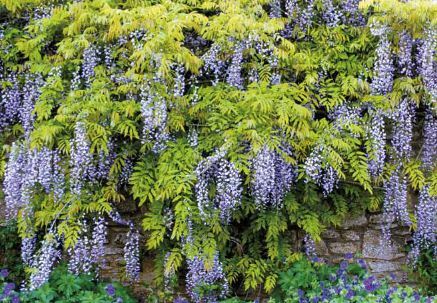
Big and beautiful, wisteria is the queen of climbers. Some would consider growing it for its gnarled, twining growth and graceful, green foliage alone, but then in early summer, it tops all this by producing a truly breathtaking display of long, pendant, scented flowers. All it needs is a little annual care.
CHOOSING PLANTS Wisteria is notorious for being slow to flower, but this is only if it is grown on its own roots. Whereas plants grown from seed may take over ten years to start flowering, grafted ones can bloom within three or four years. The nursery or garden centre should be able to reassure you about this, and you can see the graft yourself at the base of the stem, but the best way to be sure is to buy a plant in flower. The open flowers also give you the chance to decide exactly which colour you prefer.
PLANTING AND SUPPORT Wisterias are big, heavy climbers, so only plant them where you have a large, sturdy support in place such as heavy-duty wires or a pergola. Prepare the soil well before planting, digging it over and mixing in plenty of organic matter . At first you may need to tie the stems loosely to their supports, but this task won’t be necessary for long as they begin to twine .
0 notes
Text
Choosing a tree
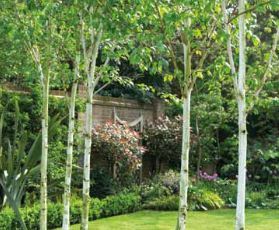
Every tree brings a range of benefits to the garden. As well as flowers and fruit, some offer sculptural shapes, coloured bark, vibrant autumn colour, and differing degrees of shade, or a combination of these qualities. The choice is wide, so decide what you want most from a tree before you buy one.
ASSESS YOUR NEEDS Trees are an investment in time, money and space, so it is important to pick one that suits your garden. Soil type and aspect are important considerations, but so too is the amount of space you have available, bearing in mind how large the tree will grow. Also remember that trees cast shade, and draw large quantities of moisture and nutrients from the soil, affecting other plants growing nearby. They can also undermine foundations with their roots, so be careful to site your tree at a distance from buildings. You should also prioritize the qualities you want from your tree, whether it’s aesthetic beauty, structure, privacy, or wildlife habitat.
SEASONAL INTEREST Some trees have several seasons of interest, and offer great garden value. Prunus serrula has spring blossom and copper bark for winter appeal. Both Malus x moerlandsii ‘Liset’ and Sorbus vilmorinii have spring flowers and autumn fruits; the Sorbus also has attractive foliage. With spring flowers, summer berries and rich autumnal tints, Amelanchier lamarkii has a lot to offer, and is ideal for smaller plots.
DESIGN EFFECTS Trees play a number of useful and decorative roles in the garden. Where there is space and a clear line of sight, consider a tree with a strong structure, such as a birch or decorative cherry, to act as a stand-alone focal point. A tree with a good canopy, such as the Indian bean tree, Catalpa bignonioides, provides shade from hot summer sun when planted close to a south-facing seating area. Large-leaved trees can also help create a tropical effect in the garden. Try the fragrant snowbell, Styrax obassia, with its scented white flowers, or the evergreen loquat, Eriobotrya japonica, an ideal choice for year-round privacy.
0 notes